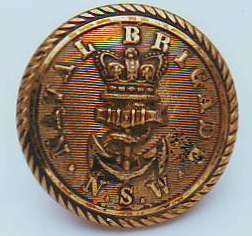- Author
- Haken, J.K., Dr
- Subjects
- History - pre-Federation
- Tags
-
- RAN Ships
- None noted.
- Publication
- September 2007 edition of the Naval Historical Review (all rights reserved)
The Naval Brigade was formed in 1863, due to the uncertainties existing in Europe. The force was effectively land based as the Government never provided any sea going ships, but regular drills were held and reasonable numbers were maintained. The Naval Brigade was duplicated by the formation of the Naval Artillery, volunteers in both forces eventually being under the overall command of Captain Hixson. At Federation in 1901the Naval Brigade became the Naval Forces in New South Wales and the Naval Artillery was disbanded.
While on 1 May 1863, the Governor issued a Proclamation forming the Naval Brigade, there remained much uncertainty about the role of Colonial Naval Forces, as the Imperial Government had disallowed a Colonial Navy Act passed by the Victorian Parliament in 1860 to allow the formation of Naval Services. The position was clarified by The Colonial Naval Defence Act enacted by the Imperial Parliament in 1865. The Naval Brigade was proclaimed under an Act to allow volunteers and was to consist of three companies, each of 40 men, in Sydney; a subsequent Proclamation issued soon after authorised an additional company at Sydney. Formation of a company at Newcastle was authorised in September 1863.
Being land based, the Brigade was of limited effect, as the Government never provided any seagoing warships. During its existence reasonable numbers were maintained, the enrollments being higher than usual for volunteer forces. The Captain Commanding appointed at formation was Francis Hixson RN, the Superintendent of Pilots, Lighthouses and Harbours in New South Wales, while most of the officers were also Government employees, the Lieutenant of the Newcastle company being the Newcastle Harbour Master.

Regular drills and parades were conducted, headquarters being at Bennelong Point, a site occupied by the Maritime Services Board for over 100 years and now part of the site of the Sydney Opera House.
The Naval Brigade differed from the military volunteers in that they were partially paid at inception. The payment was stopped on 1 April 1864, with the exception of the Clerk and Accountant, while Cadets were not salaried, but payment recommenced on 1 May 1865.
A sixth (torpedo) company was raised in 1873, with officers being appointed on 2 May 1873. The company was short lived, as following the report of Sir William Jervois, dated 4 June 1877, who investigated the defence of the colony, the Torpedo Company of the Naval Brigade was combined with the Telegraph Company of the Telegraph Department and transferred to the Military Forces as the Torpedo and Signaling Corps. A replacement company of the Naval Brigade was re-raised in 1879, with a seventh company being raised in 1886.
Regulations for the Naval Brigade were published in 1875, and included provision for payment for Officers and Men as determined by the Legislature.
During 1882, HMS Wolverine, the flagship of the Australian Squadron, was paid off as it had become unseaworthy. The vessel, a wooden hull screw corvette, was presented to the Colony as a royal gift. It became HMCS Wolverine and a training vessel for the Colonial Naval Forces. The vessel, due to its condition, remained largely in Sydney Harbour but made several training cruises to Jervis Bay. It was finally paid off in December 1892 and sold in August 1893. Regulations regarding training on HMCS Wolverine were published in August 1882
Naval Artillery Volunteers were raised in 1884 and seemingly duplicated the Naval Brigade; the Volunteers became part of the Partially Paid System in 1892. Lieutenant F. P. Taylor R.N. was appointed Lieutenant Commanding and Inspecting Field Officer on 25 January 1884 but is not shown on the annual listing of officers which commenced in 1886. Lieutenant W. Drake R.N. was appointed Instructor but resigned on 17 July 1884. J.H.A. Lee was appointed Lieutenant and Commander on 27 March 1884. On 3 October, Captain Hixson Commanding the Naval Brigade was appointed Captain Commanding the Naval Forces of the Colony. In the same Gazette Lieutenant G. S. Bosanquet, late R.N., was appointed Commander of the Naval Volunteers, effective 29 September 1888.
Dress Regulations for officers of the Naval Volunteers were published on 6 March 1884 and were as the Royal Navy with distinctive badges and buckles.




